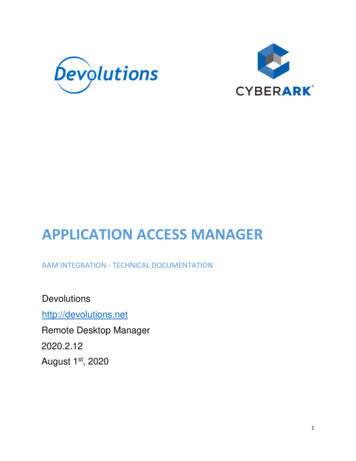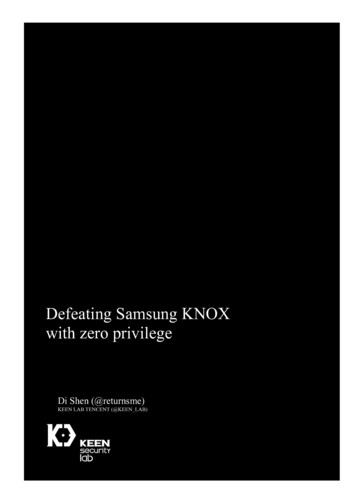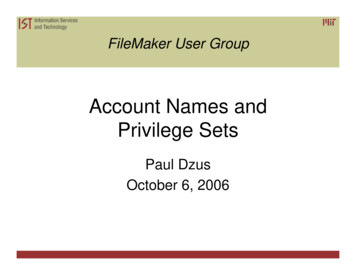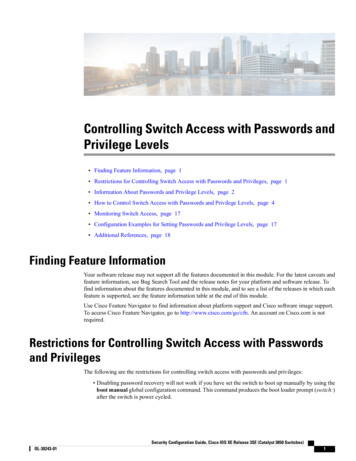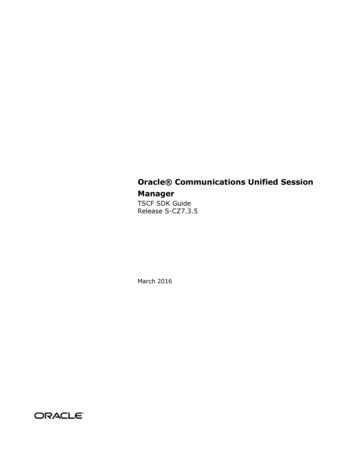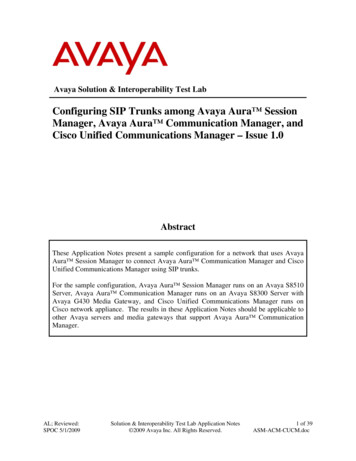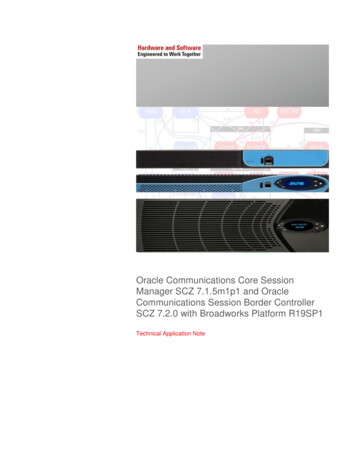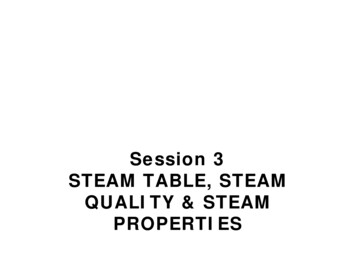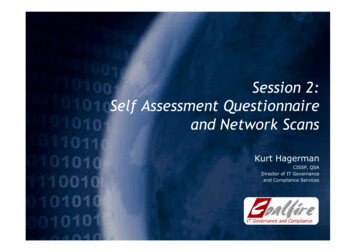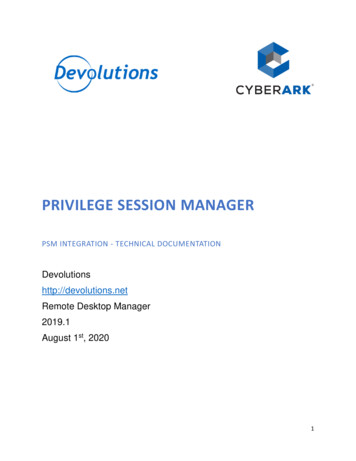
Transcription
PRIVILEGE SESSION MANAGERPSM INTEGRATION - TECHNICAL te Desktop Manager2019.1August 1st, 20201
PARTNER SOLUTION OVERVIEWRemote Desktop Manager (RDM) is a solution designed to store and securely share details ofconnections, credentials, VPNs, etc. It integrates with 160 technologies/protocols and becomes thesingle pane of glass that IT personnel uses to perform maintenance tasks, monitor system health, butmost importantly, control access to remote devices in a secure fashion.KEY BENEFITSRemote Desktop Manager enables a workflow where the IT technician simply searches for a system thatneeds to be worked on, then launches a connection towards it. If needed, a VPN client is launchedautomatically and finally the chosen protocol is launched. Most of the times the credentials areprovided automatically, but what is key is that the end user doesn’t even need to be made aware of thecredentials and, as such, they are not exposed. A strong security system is in place to grant permissionsin a flexible fashion, there is also extensive logging of user activity and full versioning of all changes.Remote Desktop Manager integrates with multiple solutions in the Remote Session space andsupporting CyberArk provides tremendous value to both CyberArk’s and Devolutions’ customer base.Following that thought, Remote Desktop Manager can connect to a PSM Server in order to connect aprivilege session as endpoint.PRODUCT DIAGRAM & DESCRIPTION OF PRODUCT INTEGRATIONDevolutions customers can elect to store their information in multiple back-ends: on premise RDBMS,cloud services, simple files, etc. The storage system used by our application is therefore omitted fromthis diagram. To ease deployment of the solution, the strategy has been to use CyberArk’s PrivilegeSession Manager. For the current customers in the pipeline, a single application server will be sufficient,but the integration would support multiple servers if need be.2
The definition of what is called a CyberArk PSM Server / Connection is stored in RDM. It contains thedetails of what us ultimately a call to the PSM Server using an Alternate Shell. No information regardingPrivileged account credentials are cached by RDM. This also implies that the user’s credentials toconnect to CyberArk must be LDAP, and both the connection to CyberArk Vault (PVWA) and the PSMserver use and are the same.In no case RDM will use the service account defined for PVWA to authenticate on the PSM Server.This implementation can support mostPSM INSTALLATIONRefer to PSM Manual Installation for CyberArk Privileged Session Manager InstallationSince our integration cannot use the PSM Windows Account to login the PSM Server, CyberArk Usersmust be LDAP integrated and granted the permission to logon the PSM Server. The Endpoint PrivilegedAccount is then used to logon the endpoint.This also means that the LDAP Account used on the PSM Server connection must be granted sufficientpermissions to access the privileged account to connect to the endpoint.3
PSM CONFIGURATIONEssentially, RDM generates a PSM connection that conforms to Privileged Single Sign-on (as .htm), but does this in a more intuitive fashion when considering not only theprivileged accounts, but also the endpoints that you want to reach.In RDM’s endpoint centric design, we have elected to create two session types-CyberArk PSM ServerCyberArk PSM ConnectionThe CyberArk PSM Server is a specialized entry that represents a single PSM server or a PSM Gateway.Since the initial connection can only use an RDP connection, rather then replicate the hundreds ofsettings that exist for that type, we’ve simplified the workflow by using a RDM template that allows youthe full flexibility of the RDP protocol. The PSM Server type is always simple, from common scenarios ina secure environment, to advanced network topologies where an RDS Gateway and/or a VPNconnection are in play.As for the PSM Connection entry, it is linked to a PSM Server, but holds only the information used tolaunch to the endpoint: Host, Privileged Account, PSM Component. It can really be corroborated to thePSM command line used for the alternate shell.IMPACT ON CYBERARK PSM OR OTHER COMPONENTSThis will not prevent CyberArk to record a session or monitor any action on the endpoint or the server4
DEVOLUTIONS RDM INSTALLATION & INTEGRATION CONFIGURATIONPrerequisitesCreate an RDP template that will reflect your requirements for reaching the PSM Server. For most of theaudience, it will most likely be a plain RDP template.If you must use an RDS Gateway, a VPN, adapt network routes, etc. this would be where you wouldapply these settings. Please refer tohttps://help.remotedesktopmanager.com/commands creatingtemplates.html for full details on thetemplates.Since you need one template per PSM Server, it makes sense to name the template in a manner thatclearly indicates the server, in our sample V-WINDPSM1A note on credentialsThe PSM ecosystem identifies the user by an exact match in its user list. Your LDAP directory matchingmay be configured to create the user simply with the SAMAccountName, or with the full UPN. The useraccount used for the connecting to the PSM Server must be typed exactly as you see in the vault userlist. As far as locating the privileged account used to connect to the endpoint, the CyberArkdocumentation is a better source of information on the topic.In our tests, we have also hit an issue when the user’s device was not on the same domain as the PSMServer. By default, RDP connections enforce Network Level Authentication (NLA) and this preventsauthentication from working. The regretful aspect of this is that Windows simply states that thecredentials are wrong. The fix is simply to disable NLA in the RDP template used for the PSM Server.August 2020 update for RDM 2020.2.18Although RDM offers multiple ways to store and share credentials, some of these options becomeundesirable when using a Vault such a CyberArk. With the greatly improved AAM integration that wasreleased in RDM 2020.2.18, RDM can be transformed to be Password Less, going as far as enabling aRDM policy to prevent any passwords from being saved.This new AAM integration in fact uses a Client Authentication Certificate to access the CCP, which thenreturns a privileged user which can be used to launch PSM connection, connect to the PVWA, etc.Depending on your organization’s security posture, using this new pattern could be a huge step forwardin controlling privileged access by any user.5
Configuration of the CyberArk PSM Server entryThe CyberArk PSM Server entry type will be the PSM Host.1. Name of the Entry (Label)2. Username / Domain / Password for the PSM Initial Connection and CyberArk Vault.a. With RDM 2020.2.18 and up, an AAM entry can be used for the greatest securityb. My Accounts Settings refer to RDM: File - My Account Settings - CyberArk PSM Server.This case is when the user has a personal account to access the PSM/PVWA.c. use a shared account. Note that entry level security in RDM will not allow users to learnthese credentials. You can create multiple entries and use RDM’s Role Based AccessControl to limit permissions.3. PSM Host Server address (IP or Hostname)4. Template An RDM template as described above in the prerequisites section.5. Connection components: this list are the default components available to a default installationof a PSM. Please adapt to removed unwanted ones, as well to reflect name changes in yourenvironment. This list is available in the PSM Connection entry when you have linked it to a PSMServer entry.6
Configuration of the CyberArk PSM Connection entryThe CyberArk PSM Connection entry is the connection to the target endpointThe PSM Connection will be using the PSM Server created above.1.2.3.4.5.Name of the Entry (Label)Hostname or IP address of the endpointPrivileged Account to use (Username field in CyberArk PVWA)PSM Server: dropdown that lists all PSM Server entries in RDM. Select the entry created aboveConnection Component is the type of connection / protocol to open. It shows only thecomponents as present in the PSM Server entry.Launching the sessionThe session (CyberArk PSM Connection) can then be launched from RDM.Some or all the following images should be seen depending on your PSM ecosystem.7
8
PARTNER CONTACT INFORMATIONBusiness ContactTechnical ContactSupport ContactNameMaurice eMaurice eSupport TeamEmailticket@devolutions.netTel844-463-04199
Feb 18, 2020 · Refer to PSM Manual Installation for CyberArk Privileged Session Manager Installation Since our integration cannot use the PSM Windows Account to login the PSM Server, CyberArk Users must be LDAP integrated and granted the permission to logon the PSM Server. The Endpoi
